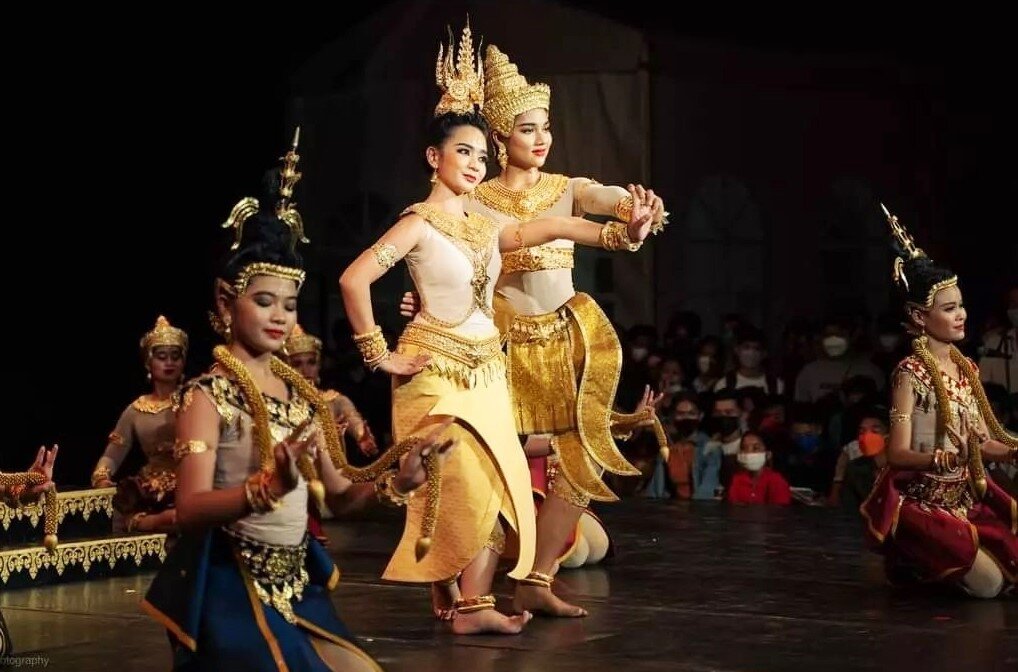A
Acharya (sk ‘He who knows the sacred writings’ kh អាចារ្យ): knowledgeable person. In modern Cambodia, the Achar assists the monks performing rituals for the community.
Adit (sk aditya): the sun.
Agni: the god of fire. Guardian of the Southeast.
Ahimsa: (sk ‘harmlessness’): the ethic of non-violence adopted by many of the ascetics of North India to counter the aggression of the new states.
Airavata, Ayravata, Airavana (kh អៃរាវតា): sacred elephant, vehicle of Indra, generally represented with three heads. Also one of the elephants supporting the four quarters of the world.
Akusala: ‘unskillful’ or ‘unhelpful’ states, which will impede the quest for Enlightenment.
Alangkar (sk alamkara, kh អលង្ការ): ornament, in a king’s name.
Amitabha: Buddha of the higher spirit, represented on the headdress of bodhisattvas.
Amrita: elixir of life, the nectar of immortality created from the churning of the Ocean of Milk.
Anatta: (sk ‘No-Soul’): the doctrine that denies the existence of a constant, stable and discrete personality.
Ananta: the multi-headed serpent on which Vishnu reclining during his withdrawal from the world. Also called Cesha.
Anantasayin, Anantasayana (sk ´sleeping on the Ananta´): epithet of Vishnu when resting on Ananta.
Anastylosis: archeological method used in Java since 1903 by the Netherlands Indies Archeological Service, by which ruined monuments were rebuilt by assembling the original stones one by one in their original order. Applied by Henri Marchal to Angkorean structures in the 1920s and 1930s, and modified by B.P. Groslier later, adding backup reinforced masonry behind the original construction.
Aňg, Ang (sk.) : body, member, manhood, Shiva’s linga, also a prince honorific title since the middle period.
Angada: the monkey warrior son of Valin.
Ang, Angka (sk anga, kh អង្គ): body, person. Preah Angka (kh ព្រះអង្គកា): a king’s name.
Aňgar, Angkor (sk. Nagara, kh អង្គរ, jp アンコール, ch 吴哥): city, capital city, kingdom. Traditionally, Angkor Thom, ‘The Great Angkor’ represents the former Khmer capital city, a group of monuments centered around the Bayon, while Angkor Touch, ‘Small Angkor’, represents Angkor Wat. The word also exists in Khmer as nokor (នគរ). One of its ancient names was Sri Yasodhar. Thai sources record in 1632 Angkor Wat was called “biṣṇuloka”, “mahā nagara”, or “braḥ nagaravāt,” literally “the temple city” or “the city of temple(s). Also called “brah jetabal” or “jet bray” at that time, a corruption of Jētavana Vihāra, monastery built for the Buddhā, term also used by Japanese pilgrims in 17th century.
Anjali (kh អញ្ជលី): ‘grand salute’, dance motion-posture expressing reverence, devotion, adoration.
Anicca: the state of ‘impermanence’, constant and fleeting change.
Antarala (sk): a small corridor linking the god’s shrine to the mandapa.
Antefix: pinnacle or other ornament that stands on a parapet. Also called Acroter.
Apsara (kh អប្សរា): celestial dancer, portrayed dancing in the skies. These celestial water nymphs and sacred dancers are often depicted as the consorts of the Gandharvas (celestial musicians).
Arahant (kh អរហត្ត): an ‘Accomplished One,’ who has attained Nibbana.
Arana (sk ‘place of stillness’): a garden dedicated to meditation.
Arcature: niche.
Ardhamandapa: shallow porch over a mandapa.
Areca palm (sk puga kh ដើមស្លា ch 檳榔 fr aréquier): also known as ‘betel tree’, Areca catechu, in Khmer ‘flowered palm tree’. Palms, flowers and nuts are often used in ancient and modern Khmer religious rites.
Arjuna: central character in the Mahabarata, the king of the Haihayas, of the Pandava tribe. Pandu, his real father, chose Indra as his ‘godly’ father. Also, the tree Terminalia Arjuna (arjun tree) symbolizing the achievement of enlightenment in Theravada Buddhism.
Arogyasala (sk ‘sickness-free pavilion’, ‘health pavilion’, kh ផ្ទះពេទ្យ, មន្ទីរពេទ្យ, ‘medical house’ ): Ancient name of the hospitals built in Angkor and across the Khmer Empire, especially at the end of 12th century, under the rule of Jayavarman VII.
Arthashastra (sk ‘The Treatise on Profit’): probably written in the second century AD and attributed to Kautilya, it expounds all aspects of practical action, including technology, economy, and public and military administration.
Asana: the correct position for yogic meditation, with straight back and crossed legs.
Asrama, Ashram (sk): a kind of monastery or retreat to which men retire when they consider that their active life is over, in order to prepare for their future existence. In ancient Angkor, the asrama, or vidyasrama, or varnnasrama, were educational colleges with teachers were called adhyapaka, and heads of association often called kulapati (cf. varnnasrama).
Ascetic: sage who practiced austerity.
Asura (sk): a class of ‘demons-monsters’, the devas’ foremost enemies.
Atman: the eternal, unchangeable Self sought by the yogins, ascetics and followers of the Samkhya philosophy. For the Upanisads, identical to brahman status.
Avalokiteshvara (sk ‘The Lord who looks down’): the most famous of all bodhisattvas, also called Lokeshvara. Pictured with four arms and carrying the amitabha (attributes) on his head-dress: a lotus, a rosary, a bottle and a book.
Avatara, Avatar (sk ‘descent’): the word is most frequently used to refer to the various incarnations of Vishnu, as he descends to earth to save the world from some danger.
Avasa: rural settlements, often built from scratch each year by Buddhist monks for monsoon retreats.
Ayatana: successive meditative planes achieved by a really advanced yogin.
Ayodhaya, Ayodhya (sk a+yodhya, ‘not to be fought, invicible’): the capital of Ramayana’s Kosala kingdom which was ruled by Dasharahta, Rarna’s father. Currently a city of India’s Uttar Pradesh, with an ongoing interfaith dispute (Hinduists and Muslims) over a sacred site.


